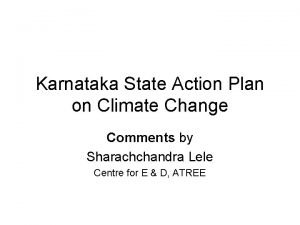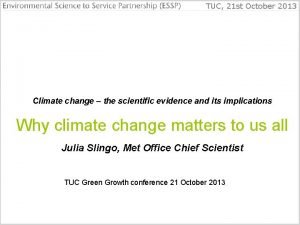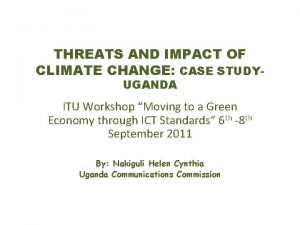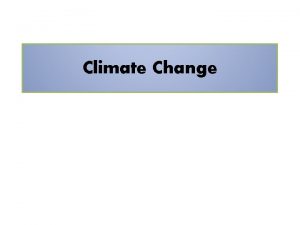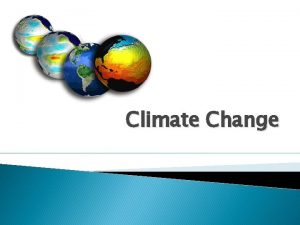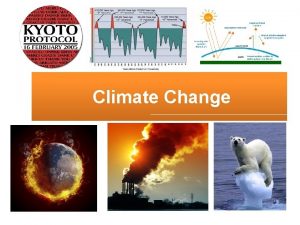Influencing Climate Change Policy in the Rapidly Developing










- Slides: 10

Influencing Climate Change Policy in the Rapidly Developing Country of Indonesia Presented in SBSTA 28 Joint Side Event: Inter-American Institute for Global Change Research (IAI) and the Asian Pacific Network for Global Change Research) Tuesday, 3 June 2008 Liana Bratasida 1 and Rizaldi Boer 2 1 APN National Focal Point and 2 Centre for Climate Risk and Opportunity Management, Bogor Agricultural University dokie@cbn. net. id rizaldiboer@gmail. com

Changes in climate and climate variability Changes in population, land use and socio-economic conditions Lesson learnt and best practices Win-Win Measures • EWS, Climate Information products and El-Nino • Hazards control measures, flood and drought management (climate information application) • Financial & economic tools: insurance system • Structural and physical measures • Land use plan • Urban risk management • Coastal zone management • Risk and vulnerability assessment • Etc Policy Strategy Program Lesson learnt and best practices On-going programs and actions to address current climate risks Projects Pilots, research activities Institutionalization of best practices Adjusting on-going and planned initiatives Multi-sectoral coordination Participatory processes Source: Boer et al. , 2007 Needs for Adaptation to address future climate risks Challenges/Strategies • Fostering a co-evolution of interdisciplinary science • Enhancing cross sector governmental communication coordination • Availability of resources • Decreasing vulnerability • Integration in sustainable development planning • Poverty reduction • Improving education/information/public awareness • Comprehensive responses, etc Horizon Plan of adaptation

• M eas ure pat s t • Im ern fo : Adju • Im prove llowing st the cro pro the cropp p v ed ma irrig clim ing i n r a a r a • Pr ig t t ovid ion eff ation gemen e fore cas ic fa t e alte t rna more iency cility a tive opp nd eco o nom rtunity • Se ic a f ctiv or t up ities field poli fun to oth cy to b • Ex ding, er us an co es i pan insu n r vuln d th anc n Jav versio • M erab e rice e sys a, sta n of r ice le a aint tem nd gro r a b w e the i y ups n and as, ne ing ar Div eas i wv ers tream ncrea a to le riet s ify f ( e c i e ss fore s ood lima con te sm st co sum ver art s ptio pat in n ial p • De lan) v vuln elop n e whe erable w irrig incr never rice p ation fa r e pro asing possib oducti cility in o duc l tivit plantin e to al n cen tr y g in low for e area dex s and Horizon Plan of Adaptation: Food Crops Sub-Sector 2005 2010 2015 2020 2025 2030 Source: Boer et al. , 2007

Indonesian Government Initiatives INDONESIA INTERNATIONAL WORLD CLIMATE CHANGE NATIONAL ACTION PLAN LIVING DOCUMENT “NATIONAL ACTION PLAN IN FACING CLIMATE CHANGE” MINISTRY OF ENVIROMENT NATIONAL DEVELOPMENT PLANNING AGENCY BAPPENAS “NATIONAL DEVELOPMENT PLANNING RESPONSE TO CLIMATE CHANGE” 1. 2. 3. 4. 5. 6. 7. 8. 9. 10. 11. Agriculture Coastal and Small Island Health Transportation Public Works Human Settlements Energy and Mining Forestry Environmental Technology Rehabilitation & Revilitation Peat Land 12. Mainstreaming Decentralized Disaster Risk Reduction IMPLEMENTATION

Line agencies GENERAL POLICY DONOR SECTORAL PRIORITY AND PROJECT DIGEST PROCESS OF NATIONAL DEVELOPMENT PLANNING: RESPONSE TO CLIMATE CHANGE FINANCIAL MECHANISM NATIONAL DEV’L PLANNING RESPONSE TO CLIMATE CHANGE Launched in Bali COP 13 / 2007 CONSULTATION PROCESS JAN - AGUSTUS Upcoming Consultation: Line Agencies Consultation: 28 May 2008 Donor Consultation: June 2008 Completed by SEPTEMBER 2008 NATIONAL DEV’L PLANNING RESPONSE TO CLIMATE CHANGE Launched in Side Event COP 14 UNFCCC/ 2008 Source: Deputy Chairman for Natural Resource and Environment Affairs, National Development Planning Agency (BAPPENAS, 2008)

APN CAPa. BLE Indonesia • PROJECT goal is to increase adoption of climate information for managing climate risks through Enhancement of Policy-Science-Community Networking • APN CAPa. BLE is expected to contribute to the development of boundary institutions, an institution that bridge science community, policy makers and communities (end users) to produce attractive and relevance climate information applications (CIA) for managing current and future climate risks, and to assist the process of integrating climate change issues into national development policies • Science community, policy makers and communities Network developed at local can play role in the process of increasing resilience of agriculture system to climate variability and climate change

APN-CAPa. BLE Process: Indonesian Case Regional BMG AARD IPB/ Universities Ditlin Strengthening networking, building knowledge and leadership (agents of change) Local Gov’t Workshop Local/National Capacitating farmers to manage climate risk Action Researches for managing climate risk in the selected sites BP 2 TP Local Workshops Local Scientist Identification of climate re. problems Local Scientist Workshop/Training Local Scientist BMG HQ Field School (FS) development Building Network

APN-CAPa. BLE Process: Indonesian Case • CAPa. BLE APN can contribute to the process of developing effective climate information system, a system which is able to provide climate information which is easy to understand, meet the client needs and gets into the hands of appropriate users in a timely fashion which allowing them to use it for making appropriate decision

Component of Effective Climate Information System d 4 an m ( ionyste t ican S n u m atio m in Co em ss i D ) Communication and Dissemination System (4) Climate data observation/ generation and analysis Modified from Ropelewski System (1) and Lyon (2003) USERS D C i ss om e m m ina unic t i on atio S y na s temnd (4) • BMGs play significant role in developing the first three components • BP 2 TP, AARD, University contribute mainly to the development of Climate Information Application • Local Governments contribute mainly to development of effective communication and dissemination system • Farmers as users provide feed back for improvement Weather/ Climate forecast/ prediction System (3) Climate Information Production & Evaluation System (2)

 Climate change 2014 mitigation of climate change
Climate change 2014 mitigation of climate change Climate change paragraph
Climate change paragraph Karnataka state action plan on climate change
Karnataka state action plan on climate change Why are tropical climates so hot brainpop
Why are tropical climates so hot brainpop Climate change meaning
Climate change meaning Atmosphere
Atmosphere Unit 9 climate change
Unit 9 climate change Conclusion of climate change
Conclusion of climate change Youreuropemap.com
Youreuropemap.com Conclusion of climate change
Conclusion of climate change Mathematics of climate change
Mathematics of climate change


